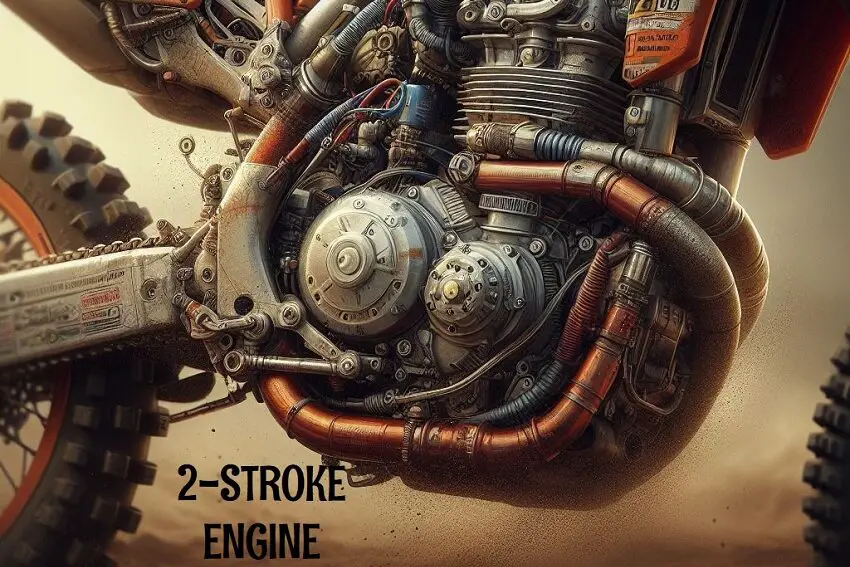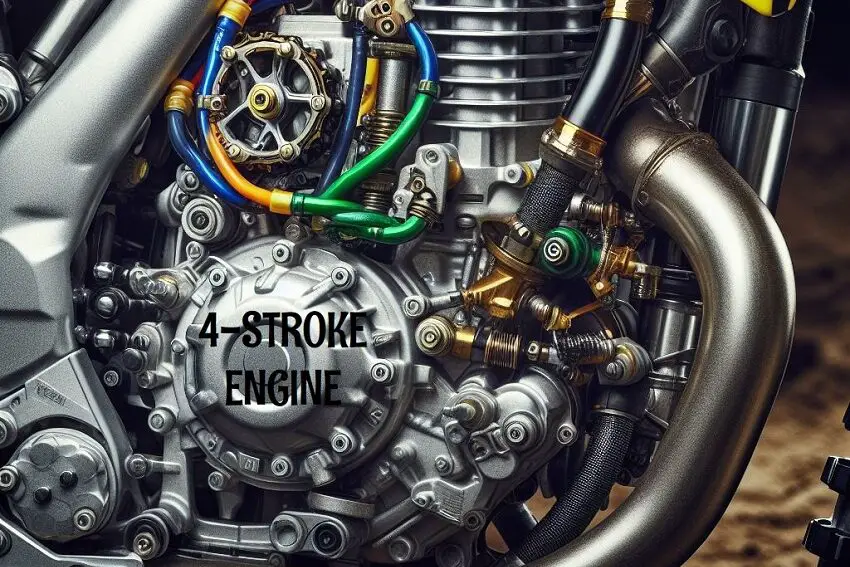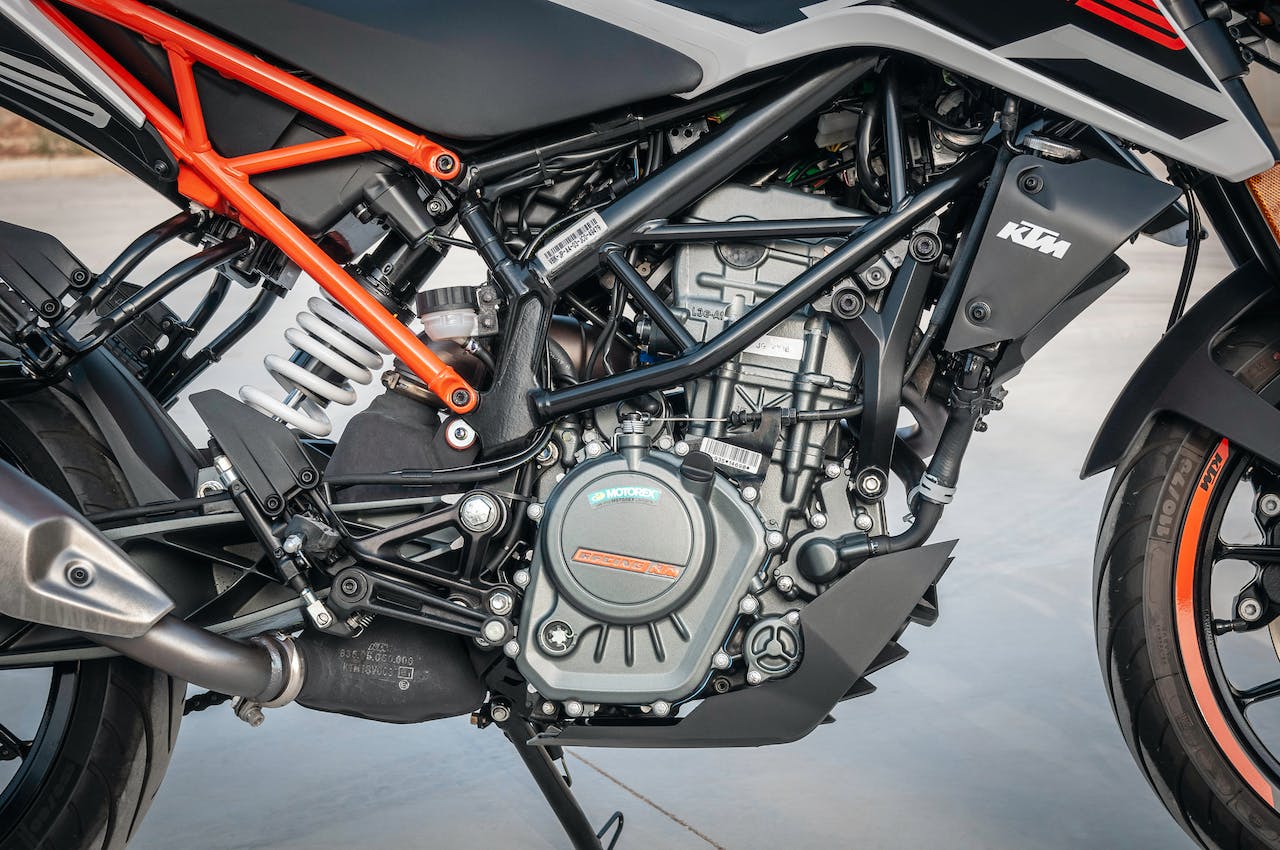Choosing between a 2-Stroke Engine vs. 4-Stroke Engine for your dirt bike isn’t just about picking an option; it’s about understanding the heart of your ride. These two distinct powerhouses drive the exhilaration of off-road adventures in unique ways.
2-strokes are lighter, snappier, and easier to learn, but guzzle fuel, require pre-mixing, and need more TLC(Tender Loving Care). 4-strokes are smoother, more efficient, and require less maintenance, but feel heavier and have a less exciting powerband.
So, whether you crave the high-revving simplicity of a 2-stroke engine or the torque-rich, efficient performance of a 4-stroke engine, diving into their mechanisms sheds light on how these engines propel your dirt bike experience.
Let’s explore the workings of these engines, dissecting their differences and uncovering the reasons behind the passionate debates in the dirt biking community.
Understanding The 2-Stroke Engine

The 2-stroke engine operates on a cycle that completes combustion in two movements of the piston. The 2-stroke engine is also known for its straightforward design and swift power delivery. Here are a few of its basic features:
Simpler Design
In the world of dirt bike engine mechanics, the beauty of a 2-stroke engine lies in its elegant simplicity. Some of such features are explained below:
No Valves, No Fuss
The most striking difference lies in the absence of valves and a complex valve train in 2-strokes. Unlike 4-strokes, where precise timing of intake and exhaust valves is crucial, 2-strokes rely on strategically placed ports in the cylinder wall. These ports act like doorways, allowing the air-fuel mixture to enter and exhaust gasses to escape at specific points in the piston’s movement. This eliminates the need for complex camshafts, rocker arms, and springs, resulting in a significantly lighter and more compact engine.
Transfer Ports, Tuned for Efficiency
Instead of valves that open and close, 2-strokes utilize transfer ports located near the crankcase. As the piston rises, it first uncovers the exhaust port, allowing spent gasses to escape. Then, it opens the transfer port, directing the fresh air-fuel mixture from the crankcase into the cylinder. This simple yet effective design ensures efficient scavenging, where fresh mixture pushes out remaining exhaust gasses, maximizing combustion efficiency within the compact space.
Lightweight Agility
The absence of numerous moving parts in the valve train not only simplifies maintenance but also sheds significant weight. This translates directly to a lighter engine and, consequently, a more agile and responsive dirt bike. Imagine the difference between maneuvering a nimble mountain bike and a heavy cruiser – the 2-stroke’s simplicity grants it agility that shines in tight turns and jumps.
By eliminating the need for complex valve mechanisms and embracing strategically placed ports, 2-stroke engines achieve a remarkable level of simplicity, making them lighter, easier to work on, and contributing to their signature responsiveness.
This streamlined design, though sacrificing some fuel efficiency and requiring more frequent maintenance, offers a unique charm and performance advantage for riders who prioritize agility and control.
Faster Power Delivery
Imagine two engines, one like a steady drumbeat, the other like a rapid-fire pistol. This analogy captures the essence of 2-stroke engine’s faster power delivery compared to its 4-stroke counterpart.
Power on Demand
Unlike 4-strokes, where combustion only happens once every four piston strokes, 2-strokes ignite the fuel-air mixture every time the piston moves upwards. This means you get a quicker, more immediate response to throttle inputs, translating into instant bursts of power whenever you need them. Think of it like tapping the accelerator and feeling a surge of energy propel you forward instantly, like a motorcycle with a nitrous oxide boost.
Technical Terrain Tamer
This explosive power delivery is especially beneficial for technical riding. In tight turns, jumps, and obstacles, the ability to unleash power instantly helps you maneuver precisely and react quickly to changing terrain. Imagine navigating a rocky trail – with a 4-stroke, you might have to wait for the engine to build up power, but a 2-stroke lets you instantly burst through each challenge with a flick of the wrist.
Responsive Rhythm
The rapid-fire nature of 2-stroke combustion creates a different powerband compared to 4-strokes. While 4-strokes offer a smooth, linear power curve, 2-strokes deliver their power in a punchier, more aggressive way. This might feel intimidating for some, but for others, it’s like riding a wave of adrenaline, constantly engaged with the engine’s energetic thrumming.
Not Just Power, but Control
The immediate power delivery of 2-strokes doesn’t just translate to speed – it also offers precise control. The responsiveness makes it easier to modulate the power output, allowing you to feather the throttle for delicate maneuvers and unleash full power when needed. Imagine the difference between steering a sluggish cruise ship and a nimble speedboat – the 2-stroke gives you the agility to dance with the terrain.
Faster power delivery isn’t just a technical advantage, it’s a different riding experience. It’s about feeling the engine’s pulse in every throttle input, responding instantly to your commands, and carving through technical challenges with a surge of power. 2-strokes might not be for everyone, but for those who crave instant gratification and explosive control, they offer a thrilling ride that’s hard to match.
Fuel Efficiency and Maintenance
Imagine your dirt bike as a hungry beast. In a 2-stroke, you feed it a potent cocktail of fuel and oil, while in a 4-stroke, you offer separate courses of fuel and oil. This difference in dining habits leads to some interesting trade-offs:
Burning Oil for Lubrication
Unlike 4-strokes with separate oil systems, 2-strokes mix oil directly into the fuel. This lubricates the moving parts within the engine, but it also comes with a cost. The oil burns along with the fuel, leading to higher emissions and lower fuel economy. Think of it like adding butter to your cereal – it adds richness, but it also makes the bowl less healthy and lasts a shorter time.
Pre-Mixing, A Customized Cocktail
The oil-to-fuel ratio in a 2-stroke is crucial for optimal performance. You need to prepare the mixture yourself before each ride, ensuring the right balance for your engine and riding style. This adds an extra step to your routine, but some riders appreciate the control it offers. It’s like hand-crafting your own coffee blend instead of grabbing a pre-made one – you get more control, but it takes more time and effort.
Higher Maintenance, A Hungrier Beast
The constant combustion of the oil-fuel mixture in 2-strokes creates more wear and tear on internal components like pistons and rings. These parts need more frequent replacements compared to 4-strokes, requiring more time and money for maintenance. Think of it like changing your bike’s tires more often because you’re riding aggressively on rough terrain.
The Trade-Off
While 2-strokes sacrifice fuel efficiency and require more maintenance, they offer a lighter, more responsive engine due to their simpler design. This translates to quicker accelerations and better agility, making them ideal for technical riding and riders who prioritize performance over fuel economy and convenience.
Ultimately, the choice between a 2-stroke and a 4-stroke depends on your priorities. If you crave the thrill of quick bursts of power and enjoy tinkering with your machine, a 2-stroke might be your perfect match. But if you value fuel efficiency, convenience, and lower maintenance, a 4-stroke might be a better fit.
Understanding The 4-Stroke Engine

Imagine your dirt bike as a well-oiled machine, not in the literal sense, but in the sense of controlled power and efficiency. That’s the essence of a 4-stroke engine, where complexity translates to smoothness and sophistication. Here’s a breakdown of their key features:
Power and Refinement
Let’s dive deeper into the intricacies that define the power and refinement of 4-stroke engines, setting them apart from their 2-stroke counterparts.
Precise Valve Control
Imagine the air intake and exhaust of a 2-stroke engine like a single, fixed gate. It opens and closes at specific points in the piston’s cycle, but the flow is always happening. Now imagine a 4-stroke engine as an orchestra conductor, meticulously timing the opening and closing of individual instruments – the intake valves like violins welcoming fresh air, the exhaust valves like timpani drums echoing out spent gasses. This precise control lets the 4-stroke:
- Optimize Combustion: The valves open and close at just the right moment, ensuring efficient mixing of air and fuel and complete combustion. This translates to more power from every drop of fuel, meaning you go farther on each tank and generate less pollution.
- Smoother Power Delivery: Unlike the “on-off” bursts of a 2-stroke, the 4-stroke’s valves create a gradual ramp-up of power as the engine revs. Think of a smooth, flowing river compared to a series of rapids. This makes the engine easier to control, especially at low speeds and when navigating technical terrain.
- Wider Powerband: The controlled valve timing allows the 4-stroke engine to deliver usable power across a broader range of RPMs. This means you have more power on tap no matter what the engine speed, making it versatile for different riding styles and conditions.
Fuel Efficiency and Cleanliness
Think of a 2-stroke engine as mixing oil and paint in the same bucket. You get everything mixed together, but it’s not ideal. A 4-stroke engine is like having separate buckets for paint and thinner – you only mix them when and how much you need. This separation:
- Reduces Emissions: By burning fuel and oil separately, 4-stroke engines produce fewer harmful pollutants, making them a more environmentally friendly choice.
- Improves Fuel Economy: The efficient combustion and precise valve timing ensure that every drop of fuel is used effectively, resulting in longer rides on a single tank compared to 2-strokes.
- Less Maintenance: Because the oil isn’t burning directly in the engine, it doesn’t need to be replaced as frequently as in a 2-stroke. This translates to less downtime and more time on the dirt.
Low-End Torque
Imagine trying to push a heavy object with short bursts of force versus a steady, sustained push. That’s the difference between the power delivery of a 2-stroke and a 4-stroke. The controlled combustion and valve timing in a 4-stroke engine create more low-end torque, giving you:
- Powerful Pull-Off: You have the muscle to easily launch from a standstill and climb steep hills, making technical sections and slow crawls a breeze.
- Confident Control: The consistent power delivery makes the engine predictable and easier to manage, especially for new riders or in challenging terrain.
- Versatility: Whether you’re tackling tight turns or cruising down open trails, the low-end torque provides the power you need for any riding situation.
These are just some of the ways that the precise valve control, fuel efficiency, and low-end torque of 4-stroke engines contribute to their power, refinement, and ease of use.
Convenience and Ease
In the world of dirt bikes, convenience and ease can be just as important as raw power and performance. When it comes to 4-strokes, they excel in these areas, offering a more user-friendly experience compared to their 2-stroke counterparts. Let’s dive into the key aspects that make 4-strokes stand out:
Heavier Build, A Sturdy Trade-Off
Think of a 4-stroke engine as a rugged SUV. Its complex valve train and oil system add weight compared to the lighter, stripped-down design of a 2-stroke, which is more akin to a nimble sports car. This additional weight can slightly impact:
- Agility: Maneuvering tight turns and navigating technical sections might feel a bit less effortless compared to a lighter 2-stroke.
- Jump performance: The extra weight can affect how high and far you can launch the bike in jumps.
However, the trade-off for this extra heft comes in the form of:
- Stability: The added weight provides a more planted feel, offering better control and confidence at high speeds and on rough terrain.
- Durability: The robust construction of 4-strokes generally translates to longer life and less wear and tear.
No Pre-Mixing, Convenience Reigns Supreme
Forget the messy task of pre-mixing fuel and oil! 4-strokes have separate tanks for each, making operation much more convenient. This eliminates the need for:
- Measuring and mixing: No more fiddling with ratios or worrying about getting the mix right. Just fill up the separate tanks and go!
- Carrying extra fuel: With pre-mixing, you often need to carry additional oil to prepare fuel on the go. 4-strokes eliminate this hassle.
Overall, the separate fuel and oil system adds a layer of convenience and ease to your dirt bike experience, making it a perfect choice for riders who value hassle-free operation.
Lower Maintenance, A Time-Saving Advantage
Imagine a self-cleaning oven compared to a stove that needs constant scrubbing. 4-stroke engines, thanks to their efficient combustion and robust construction, generally require less frequent maintenance compared to 2-strokes. This means:
- Fewer parts to replace: The simpler design of 2-strokes translates to more frequent replacements of parts like pistons and rings due to the constant wear and tear from burning oil.
- Less time spent wrenching: You can spend more time riding and less time tinkering with your 4-stroke engine.
Of course, some maintenance is still necessary for any engine, but the overall burden is significantly lower with 4-strokes, making them ideal for riders who prioritize convenience and maximizing their time on the trails.
Ultimately, 4-stroke engines prioritize control, efficiency, and convenience, while 2-strokes excel in lightweight nimbleness and quick bursts of power.
The choice depends on your riding style and priorities: smoother trails and long rides favor 4-strokes, while technical terrain and adrenaline-pumping thrills might make 2-strokes more appealing.
Choosing the Right Engine
Navigating the choice between a 2-stroke vs. 4-stroke engine dirt bike can feel like choosing between a fiery mustang and a sturdy wagon. Each engine excels in different ways, and ultimately, the perfect match depends on your unique riding profile. Let’s break down the key considerations for different types of riders:
Beginners and Technical Riders
- Snappy Power and Lightweight Handling: 2-strokes offer quick bursts of power and are lighter than their 4-stroke counterparts. This makes them ideal for learning, as the responsive power is easier to control, and the lighter weight allows for easier maneuvering in tight turns and technical terrain. Think of it like learning to ride a bicycle with training wheels – the 2-stroke’s responsiveness provides immediate feedback and control.
- Easier to Learn On: The simpler design of 2-strokes often translates to easier maintenance and repairs for beginners. Additionally, their snappy power can be more fun and engaging for new riders, making the learning process more enjoyable.
Long Rides and Smooth Power
- Fuel Efficiency and Smoother Power Delivery: 4-strokes shine on long adventures. Their efficient fuel usage allows you to ride further on a single tank, and the smooth, linear power delivery provides comfortable control, reducing fatigue on extended journeys. Imagine cruising across vast landscapes on a reliable, fuel-efficient steed.
- Less Maintenance: Generally, 4-strokes require less frequent maintenance compared to 2-strokes, meaning more time on the trails and less time in the garage. This can be a significant advantage for riders who prioritize exploring and enjoying the ride.
Racing and Performance
- Faster Power Delivery and Lighter Weight: In the adrenaline-pumping world of racing, both engines have their fans. 2-strokes typically offer quicker bursts of power and are lighter, giving them an edge in acceleration and tight cornering. Think of it like a high-performance race car capable of instant bursts of speed.
- Skill and Experience Matter: However, racing success depends not just on the engine, but also on the rider’s skill and experience. 4-strokes’ smooth power delivery and easier control can be advantageous for some riders, especially on longer, more demanding races.
In short, the best engine for you is the one that feels right. Research different models within your chosen category, and ideally, test ride both types of bikes to experience the difference in power delivery and handling firsthand.
Remember, the perfect engine is the one that complements your riding style and preferences, allowing you to conquer trails, explore landscapes, and experience the exhilarating freedom of dirt biking in a way that feels most enjoyable and rewarding.
FAQs On 2-Stroke Engine Vs. 4-Stroke Engine
In pure acceleration, 2-strokes often reign supreme, but for top speed and sustained performance, 4-strokes typically take the crown. It’s a battle of quick burst vs. steady gallop.
4-strokes boast more low-end torque and overall power, but 2-strokes pack a heavier punch in peak power per engine size. It’s a trade-off between smooth, strong pulling power and explosive bursts!
The biggest difference is how they breathe: 2-strokes mix oil with fuel for every power cycle, while 4-strokes keep them separate, leading to higher emissions and quicker wear in 2-strokes but easier pre-mixing and snappier power.
2-stroke engines are loud because they fire twice per revolution, packing more explosions into less time, like rapid bursts on a drum rather than slow, steady beats.
Final Thoughts
In the dynamic world of dirt biking, the choice between 2-Stroke Engine Vs. 4-Stroke Engine isn’t just about the engines; it’s about the essence of the ride. The 2-stroke engine embodies simplicity and immediate, adrenaline-pumping power, reminiscent of lightning-fast bursts that thrill riders seeking high-revving adventures.
Conversely, the 4-stroke engine offers a refined, controlled performance with its precise valve operation and torque, catering to diverse terrains and riding styles.
This debate isn’t about picking a winner; it’s about celebrating the diverse flavors these engines bring to the dirt biking experience. Riders gravitate toward their preferred engine based on their individual preferences and the kind of thrill they seek on the untamed trails.
Whether it’s the instant, raw power of a 2-stroke or the balanced, versatile performance of a 4-stroke, both engines contribute uniquely to the exhilaration of conquering off-road challenges.
Ultimately, the choice between these engines isn’t just a mechanical decision; it’s about finding the engine that resonates with your riding style and fuels your passion for adventure on two wheels.

